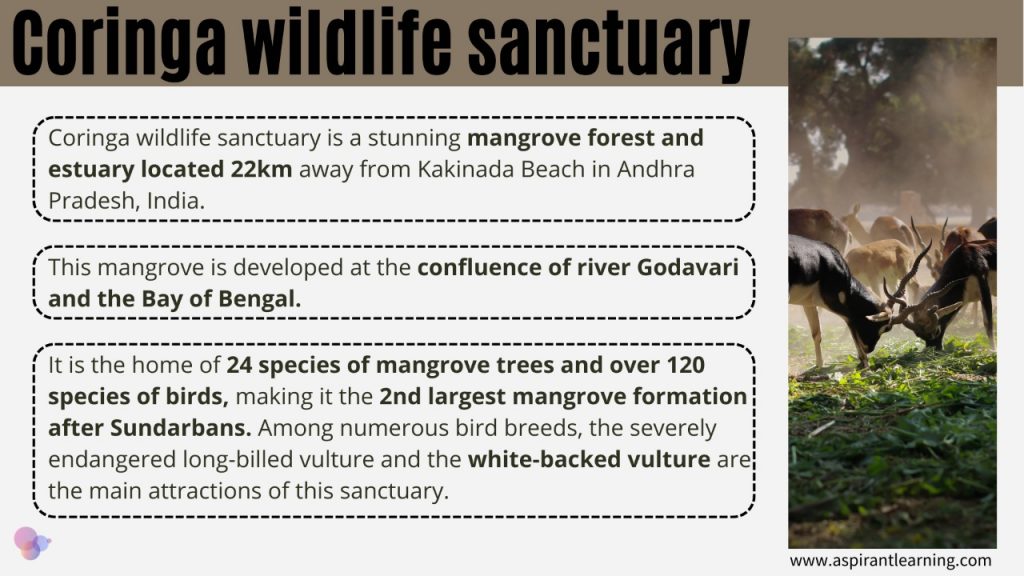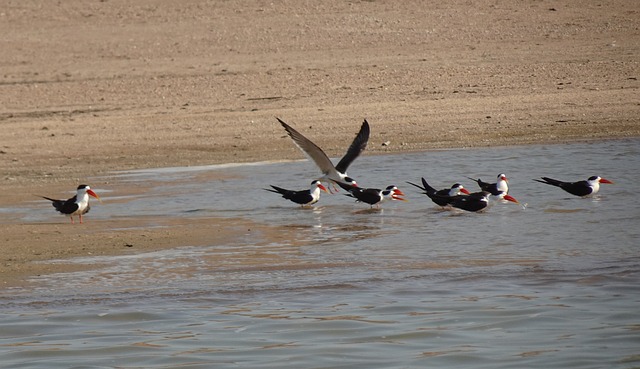News highlights:
Around 250 Indian Skimmer, which have been included in the IUCN Red list of endangered species, were sighted in Coringa Wildlife Sanctuary, an estuary situated near Kakinada in Andhra Pradesh, on a day during the Asian Waterbird Census-2023
Key Takeaway:
The Godavari estuary in Andhra Pradesh has become a prime and safe habitat for the Indian Skimmer ( Rynchops albicollis).
Indian Skimmer
- About
- The Indian skimmer or Indian scissors-bill (Rynchops albicollis) is one of the three species that belong to the skimmer genus Rynchops in the family Laridae.
- A thick, orange-yellow bill with a slightly longer lower mandible (jaw) is one of the most striking features of the Indian skimmer (Rynchops albicollis).
- The Indian skimmer grows to a length of 40-43 cm.
- Distribution and habitat:
- More widespread in winter, the Indian skimmer is found in the coastal estuaries of western and eastern India.
- It occurs primarily on larger, sandy, lowland rivers, around lakes and adjacent marshes and, in the non-breeding season, in estuaries and coasts.
- About 20% of the total population of fewer than 2,500 birds nest along river Chambal.
- Conservation Status:
- IUCN: Endangered
- In 2020, the Bombay Natural History Society (BNHS) initiated a ‘Guardians of the Skimmer’ programme, a community-based conservation initiative.
- BNHS, in collaboration with Bird Count India, have also initiated ‘Indian Skimmer Count’, a citizen science initiative.
- Threats:
- It is threatened by habitat loss, degradation, pollution, and human disturbance.
- Most colonies of Indian Skimmers are unprotected, but some lie within nature reserves such as National Chambal Sanctuary in India.

Asian Waterbird Census (AWC):
- About:
- The AWC is conducted in January each year and is coordinated by the Wetlands International South Asia and the Bombay Natural History Society in India.
- It is an integral part of the global waterbird monitoring programme, the International Waterbird Census (IWC), coordinated by Wetlands International.
- It runs in parallel with other international Waterbird Census regional programmes in Africa, Europe, West Asia, the Neotropics and the Caribbean.
- It was initiated in 1987 in the Indian subcontinent and has since grown rapidly to cover the major regions of Asia.
- Features:
- It is the longest-running citizen science initiative.
- Under this initiative, systematic counting and monitoring of waterbirds is undertaken to study trends and conditions of wetlands covering hundreds of sites.
- The census witnesses the participation of thousands of volunteers according to the international protocol and methodology to record the status of essential wetlands and waterbirds’ diversity with population estimates.
- This citizen-science programme supports the global conservation of wetlands and waterbirds.
- The census report is shared with other national and international organisations to create a global policy for conserving wetlands and waterbirds.
- Aim:
- To obtain information on an annual basis of waterbird populations at the region’s wetlands during most species’ non-breeding period.
- To monitor on an annual basis the status and condition of wetlands
- To encourage greater interest in waterbirds and wetlands among citizens
- This programme supports the conservation and management of wetlands and waterbirds worldwide.

Conclusion:
- Sustainable expansion of the human footprint along with inputs from conservation social sciences (which streamlines various disciplines to achieve sustainable conservation outcomes), can help arrest the dwindling number of bird species.
- Human needs should be reconciled with nature. Anthropogenic development should be made sustainable with other creatures of nature.
Pic Courtesy: Pixabay
Content Source: The Hindu



